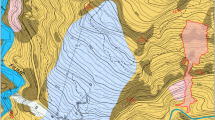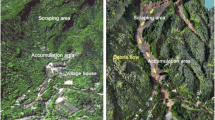Abstract
On July 20, 2013, a landslide-induced debris flow occurred in Dujiangyan city, China. Eleven houses were destroyed with more than 166 fatalities. Previous literature indicated that the 2008 Ms 8.0 earthquake and a long period of heavy rain contributed to this landslide. The rock slide was initiated and 21% of the rupture mass fell from the cliff. These rocks fragmented when impacting the ground and then entrained the base soil. Subsequently, the volume of rockfall increased by 28%. In an area of flow convergence, a short-lived blockage occurred, and the following outburst triggered a debris flow. Previous field investigations have shown that both topography and bed entrainment affect the landslide-debris flow transformation. However, the dynamic process has not been quantified. In this study, the discrete element method (DEM) considering the dragging and rolling effects was used to perform a back numerical analysis to capture the dynamic processes. The computational results indicate two different entrainment scenarios, plowing and shearing. The former occurred when the rock slide detached from the cliff, and the latter occurred when debris material moved above the colluvium. The landslide transformed into a debris flow during a short-term blockage that occurred in the gradually narrowing channel. During flow convergence, the inertial shearing stress developed due to the inter-particle collision.





















Similar content being viewed by others
References
ASTM (2013) Standard practices for measuring the density of soils. Annual Book of ASTM Standards, 1–13
Baselt I, Queiroz de Oliveira G, Fischer J-T, Pudasaini SP (2021) Evolution of stony debris flows in laboratory experiments. Geomorphology 372:1–27
Borykov T, Mege D, Mangeney A, Richard P, Gurgurewicz J, Lucas A (2019) Empirical investigation of friction weakening of terrestrial and Martian landslides using discrete element models. Landslides 16(6):1121–1140
Chen XZ, Cui YF (2017) The formation of the Wulipo landslide and the resulting debris flow in Dujiangyan City. China J Mt Sci 14(6):1100–1112
Choi CE, Goodwin GR (2020) Interaction between granular flows and flexible obstacles: a grain-scale investigation. Comput Geotech 128(11):103800
Cui P, Guo CX, Zhou JW, Hao MH, Xu FG (2014) The mechanisms behind shallow failures in slopes comprised of landslide deposits. Eng Geol 180:33–34
Cui YF, Choi CE, Liu LHD, Ng CWW (2018) Effects of particle size of mono-disperse granular flows impacting a rigid barrier. Nat Hazards 91(3):1179–1201
Cundall PA, Strack OD (1979) A discrete numerical model for granular assemblies. Geotechnique 29:47–65
Dai FC, Lee CF, Wang SJ (1999) Analysis of rainstorm-induced slide-debris flows on natural terrain of lantau island, hong kong. Eng Geol 51(4):279–290
De Blasio FV, Breien H, Elverhøi A (2011) Modelling a cohesive-frictional debris flow: An experimental, theoretical, and field based study. Earth Surf Process Landf 36(6):753–766
Du GL, Zhang YS, Yao X, Guo CB, Yang ZH (2016) Formation mechanism analysis of Wulipo landslide-debris flow in Dujiangyan city (in Chinese). Rock Soil Mech 37:493–501
Ersoy H, Karahan M, Gelisli K, Akgun A, Anilan T, Sunnetci MO, Yahsi BK (2019) Modelling of the landslide-induced impulse waves in the Artvin Dam reservoir by empirical approach and 3D numerical simulation. Eng Geol 249:112–128
Feng WK, Hu YP, Xie JZ, Wang Q, Wu G (2016) Disaster mechanism and stability analysis of shattered bedding slopes triggered by rainfall-a case study of Sanxicun landslide (in Chinese). Chin J Rock Mech Eng 35:2197–2206
Gong S, Zhao T, Zhao J et al (2021) Discrete element analysis of dry granular flow impact on slit dams. Landslides 18:1143–1152
Guo J, Yi SJ, Yin YZ, Cui YF, Qin MY, Li TL, Wang CY (2020) The effect of topography on landslide kinematics: a case study of the Jichang town landslide in Guizhou, China. Landslides 17(4):959–973
Guo J, Wang J, Li Y, Yi SJ (2021) Discussions on the transformation conditions of Wangcang landslide-induced debris flow. Landslides 173. https://doi.org/10.1007/s10346-021-01650-4
He SM, Liu W, Wang J (2015) Dynamic simulation of landslide based on thermo-poro-elastic approach. Comput Geosci 75:24–32
Hung C, Liu CH, Lin GW, Leshchinsky B (2018) The Aso-Bridge coseismic landslide: a numerical investigation of failure and runout behavior using finite and discrete element methods. Bull Eng Geol Environ 78(4):2459–2472
Iverson RM, Reid ME, Lahusen RG (1997) Debris-flow mobilization from landslides. Annu Rev Earth Planet Sci 25(1):85–138
Iverson RM (2012) Elementary theory of bed-sediment entrainment by debris flows and avalanches. J Geophys Res-Earth 117(F3):1–17
Iverson RM (2015) Scaling and design of landslide and debris-flow experiments. Geomorphology 244:9–20
Johnson BC, Campbell CS, Melosh HJ (2016) The reduction of friction in long runout landslides as an emergent phenomenon. J Geophys Res-Earth 121(5):881–889
Kang C, Chan D (2017) Modeling of entrainment in debris flow analysis for dry granular material. Int J Geomech 17(10):04017087
Kang C, Chan D (2018) Numerical simulation of 2D granular flow entrainment using DEM. Granul Matter 20(1):13
Kang C, Chan D, Su F, Cui P (2017) Runout and entrainment analysis of an extremely large rock avalanche—A casestudyof Yigong, Tibet, China. Landslides 14(1):123–139
Kharismalatri HS, Ishikawa Y, Gomi T, Shiraki K, Wakahara T (2017) Small flume experiment on the influence of inflow angle and stream gradient on landslide-triggered debris flow sediment movement. Workshop on World Landslide Forum. Springer, pp 517–523
Cascini L, Cuomo S, Pastor M, Sorbinoa G, Piciulloa L (2014) SPH run-out modelling of channelised landslides of the flow type. Geomorphology 214:502–513
Leonardi G, Pirulli, et al (2019) The force exerted by granular flows on slit dams. Acta Geotech 14(6):1949–1963
Li P, Shen W, Hou XK, Li TL (2019) Numerical simulation of the propagation process of a rapid flow-like landslide considering bed entrainment: a case study. Eng Geol 263:1–11
Li WC, Li HJ, Dai FC, Lee LM (2012) Discrete element modeling of a rainfall-induced flowslide. Eng Geol 149:22–34
Lo CM, Lee CF, Chou HT, Lin ML (2013) Landslide at Su-Hua Highway 115.9k triggered by Typhoon Megi in Taiwan. Landslides 11(2):293–304
Ouyang C, An H, Zhou S, Wang Z, Su P, Wang D, Cheng D, She J (2019) Insights from the failure and dynamic characteristics of two sequential landslides at Baige village along the Jinsha River, China. Landslides 16(7):1397–1414
Ouyang C, Zhou KQ, Xu Q, Yin JH, Peng DL, Wang DP, Li WL (2017) Dynamic analysis and numerical modeling of the 2015 catastrophic landslide of the construction waste landfill at Guangming, Shenzhen, China. Landslides 14(2):1–14
Potyondy DO, Cundall PA (2004) A bonded-particle model for rock. Int J Rock Mech Min 41:1329–1364
Savage SB, Hutter K (1989) The motion of a finite mass of granular material down a rough incline. J Fluid Mech 199:177–215
Savage SB, John WH, Theodore YW (1984) The mechanics of rapid granular flows. Adv Appl Mech 24(87):289–366
Scaringi G, Fan X, Xu Q, Liu C, Ouyang C, Domènech G, Yang F, Dai L (2018) Some considerations on the use of numerical methods to simulate past landslides and possible new failures: the case of the recent Xinmo landslide (Sichuan, China). Landslides 15(7):1359–1375
Shen W, Li T, Li P, Shen Y, Lei Y, Guo J (2018) The influence of the bed entrainment-induced rheology and topography changes on the propagation of flow-like landslides: a numerical investigation. Bull Eng Geol Environ 78(7):4771–4785
Tang H, Zou Z, Xiong C, Wu Y, Hu X, Wang L, Lu S, Criss RE, Li C (2015) An evolution model of large consequent bedding rockslides, with particular reference to the Jiweishan rockslide in Southwest China. Eng Geol 186:17–27
Wen MS, Fang ZW, W YG (2015) Characteristics and disaster causes of Wulipo landslide in Dujiangyan City (in Chinese). Geoscience 29:448–453
Xu T, Xu Q, Deng M, Ma T, Yang T, Tang CA (2014) A numerical analysis of rock creep-induced slide: a case study from Jiweishan Mountain, China. Environ Earth Sci 72(6):2111–2128
Yan Y, Cui YF, Guo J, Hu S, Wang Z, Yin SY (2020) Landslide reconstruction using seismic signal characteristics and numerical simulations: Case study of the 2017 “6.24” Xinmo landslide. Eng Geol 270:1–15
Yin Y, Cheng Y, Liang J, Wang W (2016) Heavy-rainfall-induced catastrophic rockslide-debris flow at Sanxicun, Dujiangyan, after the Wenchuan Ms 8.0 earthquake. Landslides 13(1):9–23
Yin Y, Cui YF, Tang YL, Liu DZ, Lei MY, Chan D (2021) Solid–fluid sequentially coupled simulation of internal erosion of soils due to seepage. Granul Matter 23:20. https://doi.org/10.1007/s10035-020-01076-0
Yin ZQ, Xu YQ, Zhao WJ (2014) Sanxi village landslide in Dujiangyan, Sichuan province on July 10, 2013 (in Chinese). J Eng Geol 22:309–318
Zhang Z, Walter F, McArdell BW, Wenner M, Chmiel M, de Haas T, He S (2021a) Insights from the particle impact model into the high‐frequency seismic signature of debris flows. Geophys Res Lett 48:e2020GL088994
Zhang G, Cui P, Yin Y et al (2019) Real-time monitoring and estimation of the discharge of flash floods in a steep mountain catchment. Hydrol Process 33(25):3195–3212
Zhang G, Cui P, Jin W et al (2021b) Changes in hydrological behaviors triggered by earthquake disturbance in a mountainous watershed. Sci Total Environ 760:143349
Zhou GGD, Ng CWW (2010) Numerical investigation of reverse segregation in debris flows by DEM. Granular Matter 12(5):507–516
Zhou GGD, Hu HS, Song D et al (2019) Experimental study on the regulation function of slit dam against debris flows. Landslides 16:75–90
Acknowledgements
The authors would also express their sincere appreciation to anonymous reviewers and editors for their valuable comments and suggestions.
Funding
This study was funded by the National Natural Science Foundation of China (No. 42120104002, 41941019); the Research Fund Program of the State Key Laboratory of Hydroscience and Engineering (No. 2020-KY-04); the Second Tibetan Plateau Scientific Expedition and Research Program (STEP) (No. 2019QZKK0906); the Key Research Program of Frontier Sciences, CAS (No. QYZDY-SSW-DQC006); and the Fundamental Research Funds for the Central Universities, CHD (No. 300102261712).
Author information
Authors and Affiliations
Corresponding authors
Ethics declarations
Conflict of interest
The authors declare no competing interests.
Rights and permissions
About this article
Cite this article
Guo, J., Cui, Y., Xu, W. et al. Numerical investigation of the landslide-debris flow transformation process considering topographic and entrainment effects: a case study. Landslides 19, 773–788 (2022). https://doi.org/10.1007/s10346-021-01791-6
Received:
Accepted:
Published:
Issue Date:
DOI: https://doi.org/10.1007/s10346-021-01791-6




